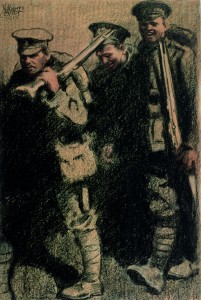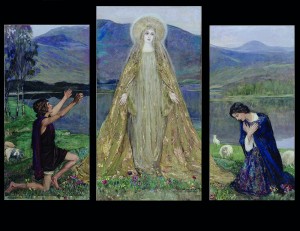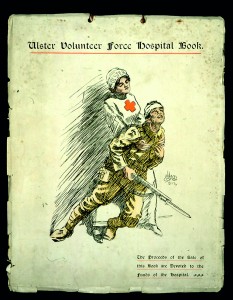William Conor’s people’s war
Published in Decade of Centenaries, Features, Issue 4 (July/August 2014), Volume 22
William Conor’s Off: the Ulster Division. (William Conor estate/Ulster Museum Collection)
Tracing the responses of Irish visual artists to the First World War usually takes us out of Ireland and to painters whose ‘Irishness’ is sometimes debated. Conventionally, the two most significant were William Orpen, a Dublin-born Protestant, and John Lavery, a Belfast-born Catholic, both of whom were appointed official war artists in 1917 by the British propaganda Department of Information.
Before 1914 William Orpen and John Lavery (who were 35 and 58 respectively at the beginning of the war) had established themselves in London as leading painters, especially of portraits. While Orpen retained a clear Irish identity, retaining a presence in Dublin and returning there every year to teach, Lavery’s ethnic status was more ambiguous. Having spent much of his youth in Scotland, he was known as one of the ‘Glasgow Boys’, a group of impressionist and post-impressionist painters that flourished in the late nineteenth century. By 1913, when he was commissioned to paint a group portrait of the royal family at Buckingham Palace, he was securely ‘British’ and, like Orpen, was a favoured portraitist of the great, the good and the rich in pre-war London.
Moved in opposite directions after 1916
After the war, their engagement with Ireland moved in opposite directions. In a way, Orpen became less while Lavery became more ‘Irish’. Orpen, after 1916, when the impact and violence of the Rising (which included the destruction of the Royal Hibernian Academy, of which he was a member) repelled him, only returned to Ireland once, and that for just one day in 1918. By the time he died in London in 1931 he was widely regarded as a leading ‘British’ artist. Though his ‘Irishness’ has since often been stressed, even in 2005 the Imperial War Museum, while staging a major exhibition of his work, described him as ‘one of the great British artists of the first quarter of the twentieth century’. While this may actually be true, it was politically incorrect to express such a thing quite so explicitly, especially for an exhibition organised in collaboration with the National Gallery of Ireland.
Lavery, by contrast, painted many Irish subjects after 1918, lived in Ireland for a while and left significant collections of paintings to public galleries in both the North and the South. One of his portraits of his Irish-American-born wife Hazel, indeed, was famously used to represent ‘Erin’ on the first Irish banknotes. By his death in 1941 he had become perhaps more unequivocally Irish than ever before in his life and career.
Although Orpen painted quite a number of individual Irishmen in his war work—some of whom are generic, like a Royal Irish Fusilier just out of the front line painted in May 1917—there is nothing else particularly ‘Irish’ in the subject-matter of his war work. This is even truer of Lavery. With only one, curious exception, most of his paintings depict the Royal Navy in the North Sea, or women’s work, mainly in hospitals, both in Britain and France.
In 1917, however, apparently responding to his wife’s urging him to ‘do something’ for his country, Lavery painted a triptych with the strikingly beautiful Hazel as the central picture of the Madonna, a role she had taken in London society tableaux vivants while fund-raising for war charities. He got his friend, the celebrated imperial architect Edwin Lutyens (whose mother was Irish), to design a ‘Celtic’ frame and presented the whole work to St Patrick’s Church in Donegall Street, Belfast, where he had been baptised and where it remains to this day.
William Conor: painter of the Protestant Belfast working class

Sir John Lavery’s 1917 triptych of the Madonna of the Lakes, featuring his wife, Hazel. (St Patrick’s Church, Belfast)
While the absence of explicitly and locally based Irish subject-matter is the outstanding feature of Orpen’s and Lavery’s war painting, quite the opposite is true of William Conor, who worked exclusively in Ireland during the war and whose work importantly covers both the military mobilisation of male manpower as well as the enlistment of civilian women into the war effort.
From the start of the war Conor painted the mobilisation of the Protestant Belfast working class. Indeed, his métier throughout his career was, above all, a warm and sympathetic depiction of the ‘ordinary people’: shipyard and mill workers (men and women), children, street scenes, farm workers and the like. Unlike Orpen and Lavery (and unlike in World War II, when he did get such an appointment), Conor was not an ‘official’ war artist. His artistic response to the conflict, therefore, was unmediated by any potential propaganda line and thus might represent a ‘purer’ response to the war than that of his more established colleagues. On the other hand, Conor had to survive as a professional artist, and he undoubtedly appreciated that there was a demand for his folksy portraits. So, in part, his war pictures might be as much a commercial and businesslike response to the prevailing circumstances as any purely artistic one.
Off: the Ulster Division
One of Conor’s most vivid early pictures of the war is Off: the Ulster Division, which depicts three young men in uniform at some time before the famous 36th (Ulster) Division left Ireland in July 1915 for England and the Western Front. Executed in Conor’s trademark charcoal and chalk, which gives the picture an immediate and impromptu feel, two of the soldiers are cheerfully embarking on what is a great adventure. The third, a little older and carry-ing a rifle over his shoulder, looks more coolly at the artist, communicating a more steadfast sense of purpose. Here, Conor has neatly picked up some of the mixed motives and emotions of enlistment, that combination of youthful excitement with the adventurous prospect of ‘going to war’, together with the evidently powerful impulsion of the so-called ‘Big Words’ intoned by the country’s political leaders: Duty; Service; Patriotism; Loyalty; even Freedom and Democracy.
Some of these men, of course, went over the top on 1 July 1916, the first day of the Battle of the Somme, when the men of the Ulster Division suffered terrible casualties and secured their lasting place in the Ulster unionist community’s historic self-image, with their unswerving commitment—even to death—to the sacred cause of the Union with Great Britain. The high cost of this in human lives, moreover, cast a shadow over the post-war years, as annually on 1 July, and at remembrance ceremonies in November, folk gathered at war memorials to remember their dead. Conor painted this too, in a 1919 picture entitled Our Glorious Dead, which showed the temporary cenotaph (a copy of the London cenotaph designed by Edwin Lutyens, with the same simple inscription, ‘Our Glorious Dead’) which was set up next to Belfast City Hall before the permanent monument was completed in 1929.
For Ulster

William Conor’s For Ulster—widely distributed as a print by McGowan and Ingram and used on the cover of the Ulster Volunteer Force Hospital Book. (Linen Hall Library)
Ulster unionist mobilisation, before and during the war, was not, how-ever, confined to men carrying arms, as Conor himself recognised and reflected. During the ‘Ulster Crisis’ the Ulster Women’s Unionist Council had organised auxiliary women’s and nursing units to support the Ulster Volunteer Force. After August 1914 this was channelled into war work. The Ulster Women’s Gift Fund raised £100,000 for soldiers’ ‘comforts’. Ulster Volunteer Force hospitals were established at home, as well as one at Pau in southern France. In 1916 Conor drew an image of a female nurse (with ‘Ulster’ written on her cap) supporting a wounded soldier. Artistically it is a poor representation: the position of both figures is awkward; the nurse has improbably long arms, and the soldier is carrying a rifle with a bayonet attached (in a hospital?). But allegorically it reflects absolutely the traditional gendered wartime roles of men and women: the former armed and prepared to fight, the latter strong yet caring.
The drawing was used in a number of ways. A widely distributed print, published by the Belfast stationers McGowan & Ingram, was entitled For Ulster and evidently sold to raise funds. It was also used on the cover of a fund-raising publication, The Ulster Volunteer Force Hospital Book, which contained pictures of the main UVF hospital opened close to Queen’s University, Belfast, in 1915, as well as other, smaller branches elsewhere in the province.
‘Foundry girl’ at Mackie’s
Beyond the conventional occupation of nursing, there were other opportunities for women in the war. Although the absence of conscription in Ireland meant that there was much less movement of women into men’s occupations than was the case in Great Britain, war contracts were good for business in Ireland, as elsewhere in the United Kingdom. The linen industry (and shirt-making in Derry) provided many female jobs, and shipbuilding and engineering firms in Belfast secured valuable munitions work. James Mackie & Sons in West Belfast produced an estimated 75 million shells during the war, and supplemented their mainly male workforce with a significant number of ‘foundry girls’. William Conor saved one of them, Madeline Ewart, for posterity in a drawing done at Mackie’s, where we see her slightly uncomfortably operating a turret lathe.
The war paintings of William Orpen and John Lavery to a very great extent reflect a national and European response to the war. While some of Orpen’s work in particular also embodies a very human and individual response to the conflict, the ‘grand narrative’ of their paintings is of the titanic struggle in which the United Kingdom engaged, especially as fought on the Western Front and (for Lavery) in the North Sea. Conor’s work embodies a more domestic and, dare one say, democratic response. Individual people—soldiers, nurses, workers—caught up in the cataclysm of the war are at the core of his images. Conor’s environment is one of ‘everyman’ and ‘everywoman’, close to home yet unable to escape the reach of the first world war. Conor’s paintings, too, are the most Irish First World War paintings of all, reminding us of how locality and community, even in Ireland, could not escape the impact of that most titanic of conflicts.
Keith Jeffery is Professor of British History at Queen’s University, Belfast.
Read More: Conor’s background
Further reading
K. Jeffery, Ireland and the Great War (paperback edn, Cambridge, 2011).
J. Wilson, Conor 1881–1968: the life and work of an Ulster artist (Dundonald, 1981).
















